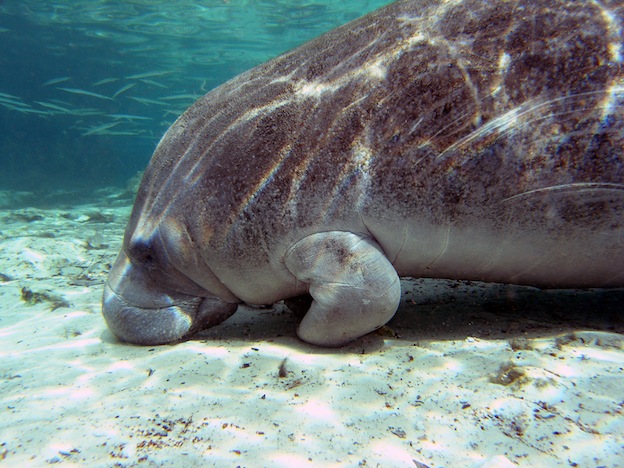What do Manatees eat?
A manatee is an herbivore, and if you aren’t familiar with that term it means that they consume plants. Researchers have identified more than 60 different types of plants that they consume. What they have access to will depend on the location that the live in as well as the time of the year. Some of their favorites include algae, leaves, and grass. Some of them will consume small fish if they can’t find enough plant life in their natural habitat.
You will notice that the manatee features what looks like an elephant’s trunk but much smaller in size. This is what they use to gather their food as well as to consume it. They will spend a great deal of their time eating when they are awake. They spend half of their day sleeping. On average a manatee will consume 9% of its body weight. Since they can be up to 1,200 pounds, that is a considerable amount of plant life that they need to have access to on a daily basis.
The manatee prefers to consume food that is very close to the surface. The most they will dive is up to 33 feet. This is because it takes so much of their energy to go up and then back down into the water. They will migrate further from their natural habitat to find food when they need to instead of staying in that same area but diving deeper. Since they don’t have a thick layer of fat, it is believed that they have to stay out of the deeper and colder water.
The exact type of food that manatees consume really depends heavily upon where they live. Those that feed off of marine vegetation eat manatee grass, turtle grass, shoal grass, and widgeon grass. Those that live off of freshwater vegetation will consume hydrilla, tapegrass, water hyacinth, and water lettuce. They are opportunistic feeders which mean they will consume any plant life that they come across.

Due to the many types of plant life they consume, manatees are considered to be primary eaters on the food chain ladder. This is why they are so often compared to cows because they have very similar feeding habits. Unfortunately there are also some types of plants in the water they have consumed that have resulted in large numbers of them dying. Researchers have tried to remove any trace of these plants from the waters in order to protect the manatees.
The female manatees will supply their young calves with nutritious milk for the first 1 or 2 years of life. These young calves are also taught to consume plants when they are a couple of weeks old. It is from their mother’s milk though that they get the sustenance that they need to grow and to thrive.
Many people find it strange that the manatee isn’t a meat eater due to their large size. The size of their bodies though is quite misleading. They don’t have layers of fact. The bulk of their middle is what is referred to as the gut track. This is where the stomach and intestines are stored. They also need to eat a large volume of plants each day because what they eat really doesn’t contain very much nutritional value.
Most of the locations that keep manatee’s in captivity feed them a diet of lettuce and a variety of green plants. It is very expensive and very difficult to grow the types of plants that the manatee would get in the wild. To help them consume less in captivity than they do in the wild they are given elephant vitamins.







